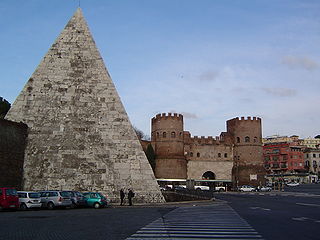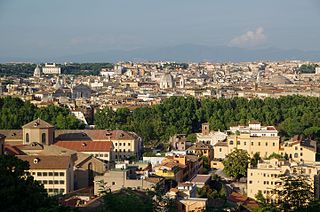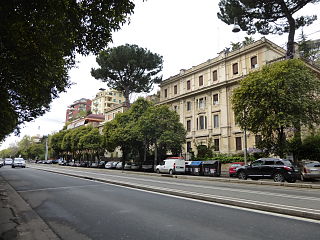
Trastevere is the 13th rione of Rome: it is identified by the initials R. XIII and it is located within Municipio I. Its name comes from Latin trans Tiberim, literally 'beyond the Tiber'.

The city of Rome, Italy is divided into first-level administrative subdivisions.

A rione of Rome is a traditional administrative division of the city of Rome. "Rione" is an Italian term used since the 14th century to name a district of a town. The term was born in Rome, originating from the administrative divisions of the city. The word comes from the Latin word regio ; during the Middle Ages the Latin word became rejones, from which rione comes. Currently, all the rioni are located in Municipio I of Rome.

Monti is the 1st rione of Rome, identified by the initials R. I, located in Municipio I. The name literally means "mountains" in Italian and comes from the fact that the Esquiline, the Viminal Hills, and parts of the Quirinal and the Caelian Hills belonged to this rione: currently, however, the Esquiline Hill belongs to the rione Esquilino.

Ponte is the 5th rione of Rome, identified by the initials R. V, and is located in Municipio I. Its name comes from Ponte Sant'Angelo, which connects Ponte with the rione of Borgo. This bridge was built by Emperor Hadrian in 134 AD to connect his mausoleum to the rest of the city. Though Pope Sixtus V changed the rione limits, so that the bridge belongs now to Borgo, not to Ponte anymore, the area has kept its name and a bridge as its coat of arms.

Regola is the 7th rione of Rome, Italy, identified by the initials R. VII, and belongs to the Municipio I. The name comes from Arenula, which was the name of the soft sand that the river Tiber left after the floods, and that built strands on the left bank.

Ripa is the 12th rione of Rome, identified by the initials R. XII, and it is located in the Municipio I.

Ludovisi is the 16th rione of Rome (Italy), identified by the initials R. XVI and located within the Municipio I.

Castro Pretorio is the 18th rione of Rome (Italy), identified by the initials R. XVIII, and it is located within the Municipio I. The rione takes its name by the ruins of the Castrum Praetorium, the barracks of the Praetorian Guard, included in the Aurelian Walls.

Testaccio is the 20th rione of Rome, identified by the initials R. XX, deriving its name from Monte Testaccio. It is located within the Municipio I.

Prati is the 22nd rione of Rome, identified by the initials R. XXII. It belongs to the Municipio I since 2013, while previously, along with Borgo and quartieri Trionfale and Della Vittoria, it was part of the Municipio XVII.

Campo Marzio is the 4th rione of Rome, identified by the initials R. IV. It belongs to the Municipio I and covers a smaller section of the area of the ancient Campus Martius. The logo of this rione is a silver crescent on a blue background.

Rome today is a popular tourist destination, due to its archaeological and artistical significance, as well as its unique traditions, its panoramic views, and its parks. Among the most significant resources: plenty of museums – —aqueducts, fountains, churches, palaces, historical buildings, the monuments and ruins of the Roman Forum, and the Catacombs. Rome is the 2nd most visited city in the EU, after Paris, and receives an average of 7–10 million tourists a year, which sometimes doubles on holy years. The Colosseum and the Vatican Museums are the 39th and 37th (respectively) most visited places in the world, according to a recent study. In 2005 the city registered 19.5 million of global visitors, up of 22.1% from 2001. In 2006, Rome was visited by 6.03 million international tourists, reaching 8th place in the ranking of the world's 150 most visited cities. The city has also been nominated 2007's fourth most desirable city to visit in the world, according to lifestyle magazine Travel + Leisure, after Florence, Buenos Aires and Bangkok. Rome is the city with the most monuments in the world. Like other Italian cities, Rome charges a tourism tax which contributes towards the maintenance of public transportation and infrastructure. It ranges from €3 to €7 per person, per night, based on the hotel or other type of accommodation used.

ATAC S.p.A. is an Italian publicly owned company running most of the local public transportation services, paid parking and incentive parking lots in Rome. More specifically, the company handles, on behalf of Roma Capitale Authority, the entire tramway, trolleybus network and metro lines, as well as most of the bus lines in the city. It also operates, on behalf of the Administrative Region of Lazio, three railways: Roma-Civita Castellana-Viterbo, Roma-Giardinetti and Roma-Lido. ATAC S.p.A., with its 2,200-kilometer-wide public transport network, its over 8,500 busses and 70,000 parking stalls, is currently one of the biggest public transportation companies in Europe and the largest in Italy.

Metropolitan City of Rome Capital is an area of local government at the level of metropolitan city in the Lazio region of the Italian Republic. It comprises the territory of the city of Rome and 120 other municipalities (comuni) in the hinterland of the city. With more than 4.3 million inhabitants, it is the third largest metropolitan city in Italy.

The following outline is provided as an overview of and topical guide to Rome:

The historic district of Rome was declared World Heritage Site by the United Nations Educational, Scientific and Cultural Organization in 1980. It covers 19,91 km² and is included in 22 rioni with 186.802 inhabitants. There are 25.000 importants archaeological sites and locations.

Gianicolense[dʒanikoˈlɛnse] is the 12th quartiere of Rome (Italy), identified by the initials Q. XII. It belongs to the Municipio XI and Municipio XII. It takes its name from the Janiculum hill, which lies in the nearby rione Trastevere and whose western extremities correspond to the area of Monteverde.

Aurelio is the 13th quartiere of Rome (Italy), identified by the initials Q. XIII. It belongs to the Municipio XIII and Municipio XIV.























